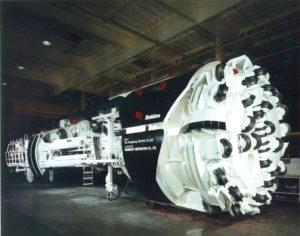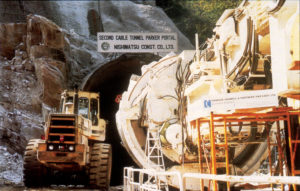![65 Years of Innovation and Experience [default]](https://www.robbinstbm.com/wp-content/uploads/2017/04/Side-Bar-Blue-Blocks_70-Years.jpg)
A Solution for Every Condition: Search our Project Database
Project Map
FEATURED PRODUCT: CROSSOVER MACHINES
Our History
A Legacy of Innovation
Information 24/7
News & Media
Insights in the Industry:
Read the Robbins Blog
 The 275 KV Cable Tunnel on Hong Kong Island provides a transmission line from a power station at nearby Lamma Island. Electricity travels through the 5.4 km (3.3 mi) long tunnel via six 275 KV cables to increase power supply to residents on the eastern side of Hong Kong Island.
The 275 KV Cable Tunnel on Hong Kong Island provides a transmission line from a power station at nearby Lamma Island. Electricity travels through the 5.4 km (3.3 mi) long tunnel via six 275 KV cables to increase power supply to residents on the eastern side of Hong Kong Island.
The Hong Kong Electric Co., owner of the project, contracted Nishimatsu Construction Co. to build the tunnel. Nishimatsu chose a 4.8 m (15.8 ft) diameter Main Beam Tunnel Boring Machine (TBM) for the project, the first ever TBM to bore in Hong Kong.
The cable tunnel passes through three mountains and beneath catch-water facilities of the Tai Tam Reservoir five times along the tunnel route. The geology consists of a granite and quartz mixture with some volcanic rocks holding hard tuffs and lavas. Hong Kong granites are considered among the world’s hardest.
Robbins equipped the high-performance TBM with thirty-two 19 inch (483 mm) disc cutters, a cutterhead thrust capacity of 10,291 kN (2,313,531 lb), and a cutterhead drive of 2,275 kW (3,050 hp). The machine’s design included adjustable side supports and hydraulic roof shields to stabilize the cutterhead and aid cutter tracking. A long boring stroke maximized boring time and kept regrips to a minimum.
 Boring on the 5.4 km (3.3 mi) long tunnel began in March 1991. The TBM advanced at a grade through granite. Initial water inflows required concrete invert section and fissure grouting to be applied along tunnel walls.
Boring on the 5.4 km (3.3 mi) long tunnel began in March 1991. The TBM advanced at a grade through granite. Initial water inflows required concrete invert section and fissure grouting to be applied along tunnel walls.
A section of the tunnel on the Wong Nei Chung fault line caused some difficulties. Shattered and weathered granites required rock support and advance probe drilling which slowed the boring process. Regardless, TBM performance remained high throughout the drive with only 55 shift hours lost to delays.
The machine broke through the tunnel in October 1991, only 53 working weeks after tunneling began. The TBM’s average advance rate was 100 m (328 ft) per week and its average rate of penetration was 2.8 m (9.1 ft) per hour.

 Close
Close